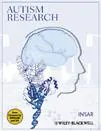[article]
| Titre : |
Proton Magnetic Resonance Spectroscopy as a Probe into the Pathophysiology of Autism Spectrum Disorders (ASD): A Review |
| Type de document : |
texte imprimÃĐ |
| Auteurs : |
Joshua M. BARUTH, Auteur ; Christopher A. WALL, Auteur ; Marc C. PATTERSON, Auteur ; John D. PORT, Auteur |
| AnnÃĐe de publication : |
2013 |
| Article en page(s) : |
p.119-133 |
| Langues : |
Anglais (eng) |
| Mots-clÃĐs : |
Autism Spectrum Disorders proton magnetic resonance spectroscopy N-acetylaspartate glutamate myo-inositol |
| Index. dÃĐcimale : |
PER Périodiques |
| RÃĐsumÃĐ : |
Proton magnetic resonance spectroscopy (1H-MRS) is a safe, noninvasive way of quantifying in vivo biochemical and metabolite concentration levels in individuals with Autism Spectrum Disorders (ASD). Findings to date suggest ASD is associated with widespread reduction in N-acetylaspartate (NAA), creatine plus phosphocreatine (Cr), choline-containing compounds (Cho), myo-inositol (mI), and glutamate plus glutamine plus gamma-Aminobutyric Acid (Glx); however, variable findings, and even substantial increases, are not uncommon depending on the study and/or region-of-interest. Widespread reduction of NAA, Cr, Cho, mI, and Glx in ASD likely reflects impaired neuronal function and/or metabolism related to abnormal neurodevelopmental processes. Future studies should attempt to relate 1H-MRS findings to histological findings and control for variability in subject age and functioning level; this would assist in evaluating the relationship between 1H-MRS metabolic levels and neuronal and glial cell densities, as well as neurodevelopmental process associated with ASD. Furthermore, more longitudinal 1H-MRS studies are needed in both control and ASD subjects to attempt to standardize metabolite levels across different developmental periods in well-defined endophenotypes. This will provide for a standard rubric for which metabolic aberrations (as well as treatment responses) can be measured. With higher magnetic field strengths and spectral-editing techniques capable of quantifying less-concentrated metabolites, 1H-MRS will continue to be an important tool in ASD research. |
| En ligne : |
http://dx.doi.org/10.1002/aur.1273 |
| Permalink : |
https://www.cra-rhone-alpes.org/cid/opac_css/index.php?lvl=notice_display&id=199 |
in Autism Research > 6-2 (April 2013) . - p.119-133
[article] Proton Magnetic Resonance Spectroscopy as a Probe into the Pathophysiology of Autism Spectrum Disorders (ASD): A Review [texte imprimÃĐ] / Joshua M. BARUTH, Auteur ; Christopher A. WALL, Auteur ; Marc C. PATTERSON, Auteur ; John D. PORT, Auteur . - 2013 . - p.119-133. Langues : Anglais ( eng) in Autism Research > 6-2 (April 2013) . - p.119-133
| Mots-clÃĐs : |
Autism Spectrum Disorders proton magnetic resonance spectroscopy N-acetylaspartate glutamate myo-inositol |
| Index. dÃĐcimale : |
PER Périodiques |
| RÃĐsumÃĐ : |
Proton magnetic resonance spectroscopy (1H-MRS) is a safe, noninvasive way of quantifying in vivo biochemical and metabolite concentration levels in individuals with Autism Spectrum Disorders (ASD). Findings to date suggest ASD is associated with widespread reduction in N-acetylaspartate (NAA), creatine plus phosphocreatine (Cr), choline-containing compounds (Cho), myo-inositol (mI), and glutamate plus glutamine plus gamma-Aminobutyric Acid (Glx); however, variable findings, and even substantial increases, are not uncommon depending on the study and/or region-of-interest. Widespread reduction of NAA, Cr, Cho, mI, and Glx in ASD likely reflects impaired neuronal function and/or metabolism related to abnormal neurodevelopmental processes. Future studies should attempt to relate 1H-MRS findings to histological findings and control for variability in subject age and functioning level; this would assist in evaluating the relationship between 1H-MRS metabolic levels and neuronal and glial cell densities, as well as neurodevelopmental process associated with ASD. Furthermore, more longitudinal 1H-MRS studies are needed in both control and ASD subjects to attempt to standardize metabolite levels across different developmental periods in well-defined endophenotypes. This will provide for a standard rubric for which metabolic aberrations (as well as treatment responses) can be measured. With higher magnetic field strengths and spectral-editing techniques capable of quantifying less-concentrated metabolites, 1H-MRS will continue to be an important tool in ASD research. |
| En ligne : |
http://dx.doi.org/10.1002/aur.1273 |
| Permalink : |
https://www.cra-rhone-alpes.org/cid/opac_css/index.php?lvl=notice_display&id=199 |
|  |


